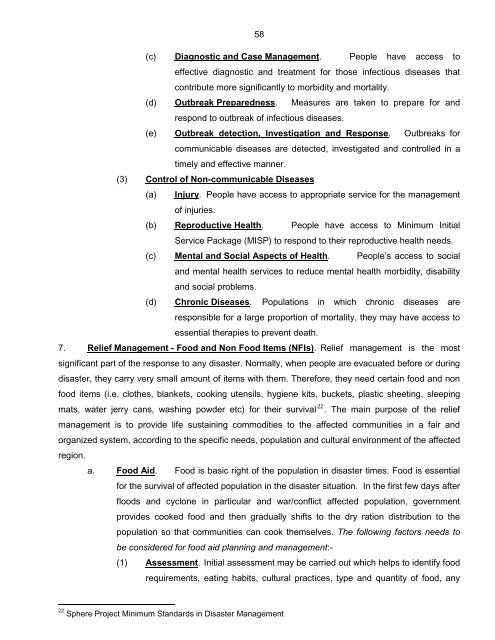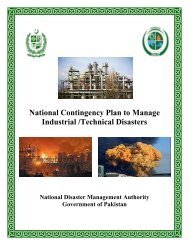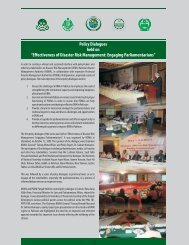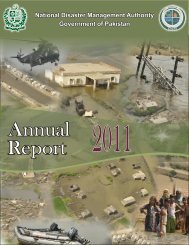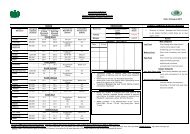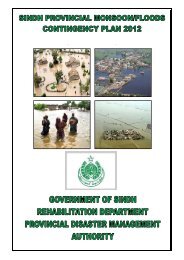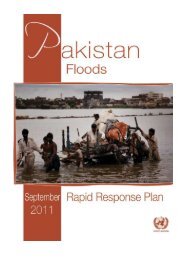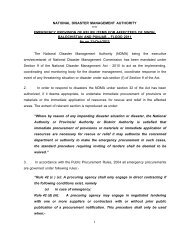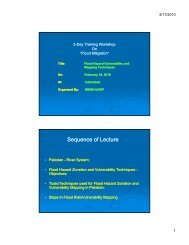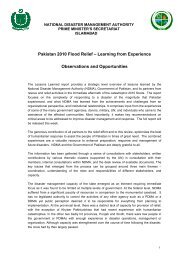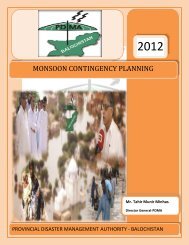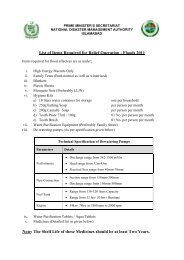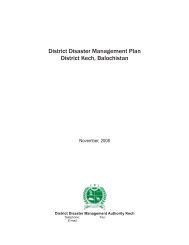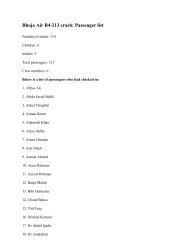National Disaster Response Plan (NDRP) March 2010 - NDMA
National Disaster Response Plan (NDRP) March 2010 - NDMA
National Disaster Response Plan (NDRP) March 2010 - NDMA
You also want an ePaper? Increase the reach of your titles
YUMPU automatically turns print PDFs into web optimized ePapers that Google loves.
58<br />
(c) Diagnostic and Case Management. People have access to<br />
effective diagnostic and treatment for those infectious diseases that<br />
contribute more significantly to morbidity and mortality.<br />
(d) Outbreak Preparedness. Measures are taken to prepare for and<br />
respond to outbreak of infectious diseases.<br />
(e) Outbreak detection, Investigation and <strong>Response</strong>. Outbreaks for<br />
communicable diseases are detected, investigated and controlled in a<br />
timely and effective manner.<br />
(3) Control of Non-communicable Diseases<br />
(a) Injury. People have access to appropriate service for the management<br />
of injuries.<br />
(b) Reproductive Health. People have access to Minimum Initial<br />
Service Package (MISP) to respond to their reproductive health needs.<br />
(c) Mental and Social Aspects of Health. People‟s access to social<br />
and mental health services to reduce mental health morbidity, disability<br />
and social problems.<br />
(d) Chronic Diseases. Populations in which chronic diseases are<br />
responsible for a large proportion of mortality, they may have access to<br />
essential therapies to prevent death.<br />
7. Relief Management - Food and Non Food Items (NFIs). Relief management is the most<br />
significant part of the response to any disaster. Normally, when people are evacuated before or during<br />
disaster, they carry very small amount of items with them. Therefore, they need certain food and non<br />
food items (i.e. clothes, blankets, cooking utensils, hygiene kits, buckets, plastic sheeting, sleeping<br />
mats, water jerry cans, washing powder etc) for their survival 22 . The main purpose of the relief<br />
management is to provide life sustaining commodities to the affected communities in a fair and<br />
organized system, according to the specific needs, population and cultural environment of the affected<br />
region.<br />
a. Food Aid. Food is basic right of the population in disaster times. Food is essential<br />
for the survival of affected population in the disaster situation. In the first few days after<br />
floods and cyclone in particular and war/conflict affected population, government<br />
provides cooked food and then gradually shifts to the dry ration distribution to the<br />
population so that communities can cook themselves. The following factors needs to<br />
be considered for food aid planning and management:-<br />
(1) Assessment. Initial assessment may be carried out which helps to identify food<br />
requirements, eating habits, cultural practices, type and quantity of food, any<br />
22 Sphere Project Minimum Standards in <strong>Disaster</strong> Management


